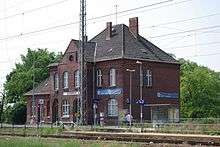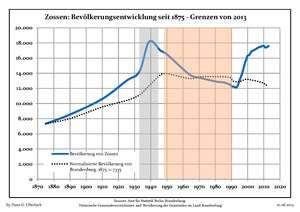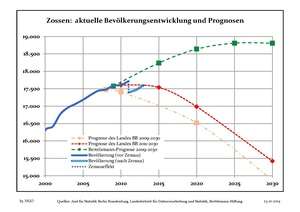Zossen
| Zossen | ||
|---|---|---|
|
Church of the Holy Trinity | ||
| ||
 Zossen | ||
Location of Zossen within Teltow-Fläming district  | ||
| Coordinates: 52°13′00″N 13°26′59″E / 52.21667°N 13.44972°ECoordinates: 52°13′00″N 13°26′59″E / 52.21667°N 13.44972°E | ||
| Country | Germany | |
| State | Brandenburg | |
| District | Teltow-Fläming | |
| Government | ||
| • Mayor | Michaela Schreiber (Ind.) | |
| Area | ||
| • Total | 179.57 km2 (69.33 sq mi) | |
| Population (2015-12-31)[1] | ||
| • Total | 17,905 | |
| • Density | 100/km2 (260/sq mi) | |
| Time zone | CET/CEST (UTC+1/+2) | |
| Postal codes | 15806 | |
| Dialling codes | 03377 | |
| Vehicle registration | TF | |
| Website | www.zossen.de | |

Zossen (Upper Sorbian: Sosny) is a German town in the district of Teltow-Fläming in Brandenburg, approximately 20 miles (30 km) south of Berlin, and next to the B96 highway. Zossen consists of several smaller municipalities, which were grouped together in 2003 to form the city.
Geography
Since the 2003 municipal reform, Zossen consists of the following districts and municipalities:
|
|
History
Zossen, like most places in Brandenburg, was originally a Slavic settlement. Its name may derive from Sosna meaning pine, a tree quite common in the region.
In 1875 Zossen station opened at the railway line from Berlin to Dresden and the Prussian military railway to the artillery range at Kummersdorf-Gut in present-day Am Mellensee. Between 1901 and 1904, Zossen adopted the use of different high-speed vehicles, such as electric locomotives and trams, for transportation to and from Berlin-Marienfelde. These vehicles were powered by an alternating current of 15kV and used a variable frequency. The power was transmitted by three vertical overhead lines.
In 1910 a proving ground and a garrison of the Imperial German Army was established at the Waldstadt section of the Wünsdorf community and also until now it is still established. In World War I it was the site of several prisoner-of-war camps, including the "crescent camp" (Halbmondlager) for Muslim fighters of the Triple Entente, where the first wooden mosque in Germany was erected. From 1939 to 1945, Wünsdorf hosted the underground headquarters of the German Wehrmacht (OKW) and Army's High Command (OKH). After World War II the area was the site of a Soviet military camp, the largest outside Russia, until 1990. Since then has been returned to civilian use as the Wünsdorf-Waldstadt book town.


Timeline
- 1809/1810: Kietz and the vineyards of Zossen are suburbanised
- 1885: Monument to the fallen soldiers of the 1864, 1866, and 1870 wars is erected in Kietz
- 1906: School on Kirchplatz is expanded
- 1910: Military area between Zossen and Wünsdorf is developed
- 1932: Flyers of the town councillor and deacon Emil Phillip regarding the threatening change in the Protestant community and the city Zossen
- 1933: As a result of the Nazis' rise to power, Socialists and Communists in Zossen are arrested by SS troops and mistreated in the school on Kirchplatz. Emil Phillip is removed from his post, upon the order of Pastor Eckerts
- 1934: Expansion of the town hall
- 1939: The military zone in Zossen is developed into military headquarters
- 1956: The city park is created
- 1992: The "Alter Krug" Zossen society is founded
- 1994: Formation of the administrative district of Teltow-Fläming from the old districts of Jüterbog, Luckenwalde, and Zossen
- 1996: 450th anniversary of Prince Elector Joachim II's awarding of rights and privileges to Zossen
Demography
 Development of Population since 1875 within the Current Boundaries (Blue Line: Population; Dotted Line: Comparison to Population Development of Brandenburg state; Grey Background: Time of Nazi rule; Red Background: Time of Communist rule)
Development of Population since 1875 within the Current Boundaries (Blue Line: Population; Dotted Line: Comparison to Population Development of Brandenburg state; Grey Background: Time of Nazi rule; Red Background: Time of Communist rule) Recent Population Development (Blue Line) and Forecasts
Recent Population Development (Blue Line) and Forecasts
Sons and daughters of the town
- Karl Friedrich August Lehmann (1843-1893), stenographer and inventor of the Stenotachygraphie]
- Frieda Kassen (1895-1970), politician (SPD)
- Walter Budeus (1902-1944), Communist and resistance fighter
- Roy Präger (born 1971), football player
See also
References
External links
| Wikimedia Commons has media related to Zossen. |
- Zossen Home page — in German only
- Military Ground Zossen Wuensdorf
- Zossen Home page — in German only

